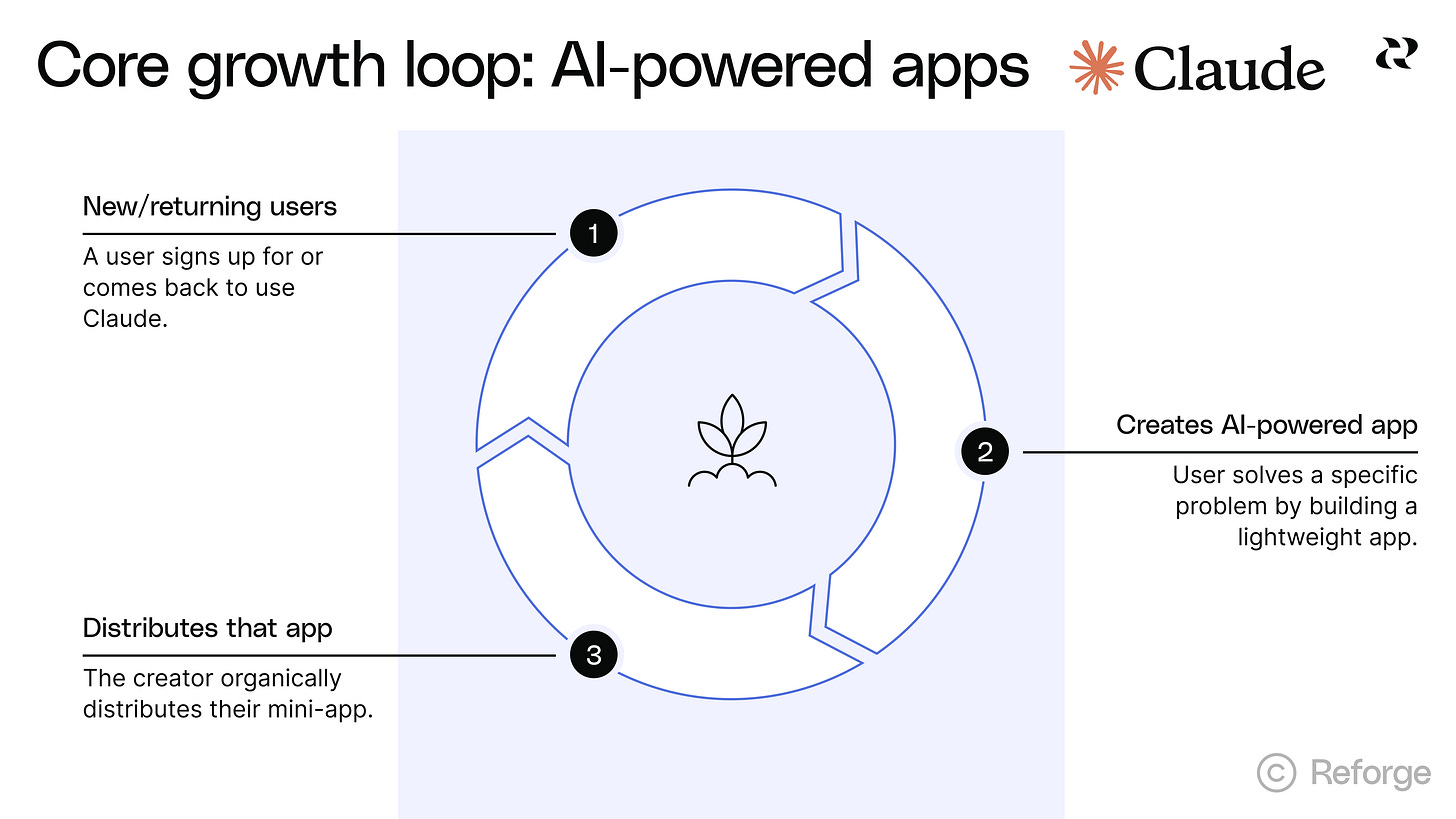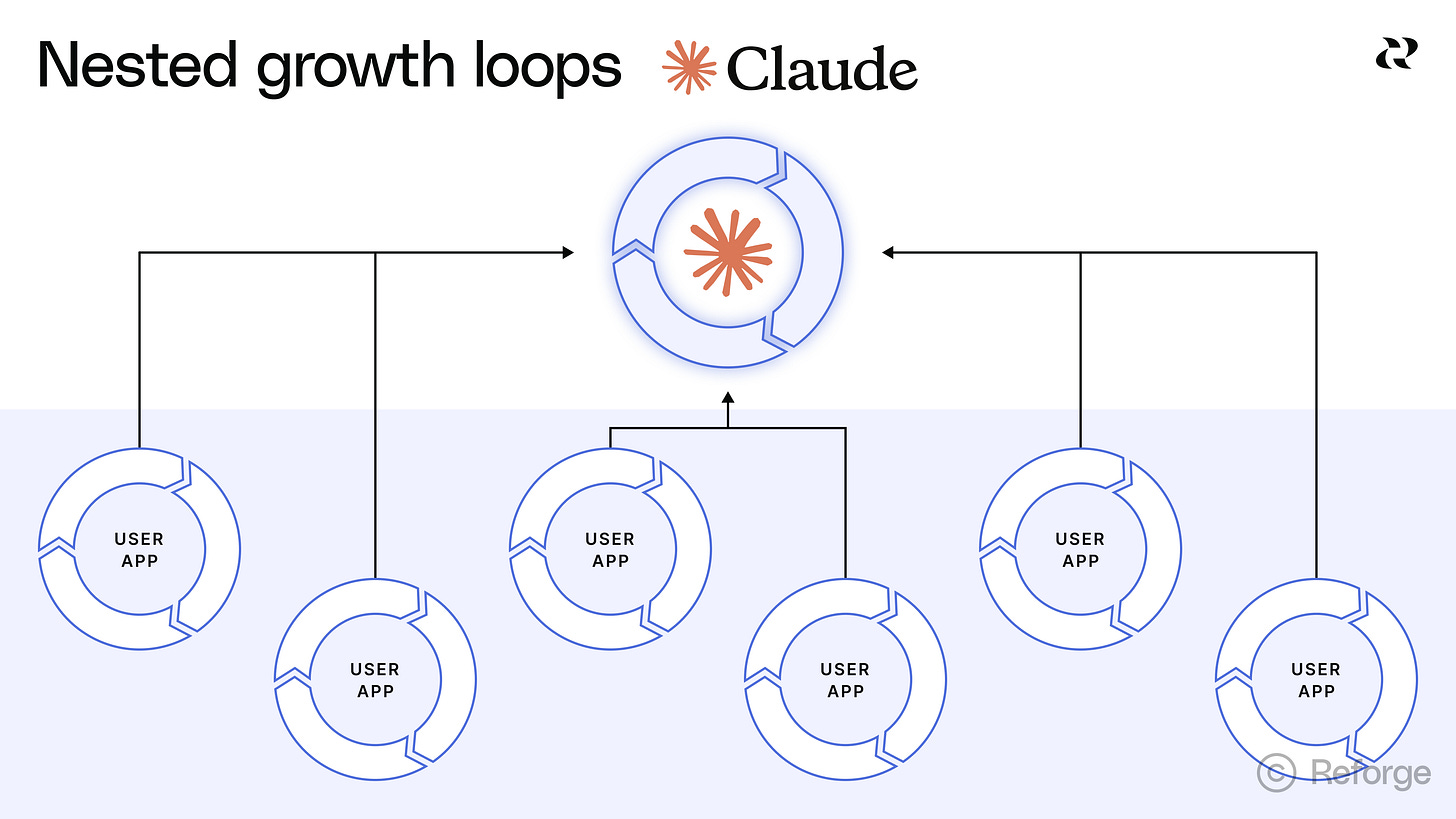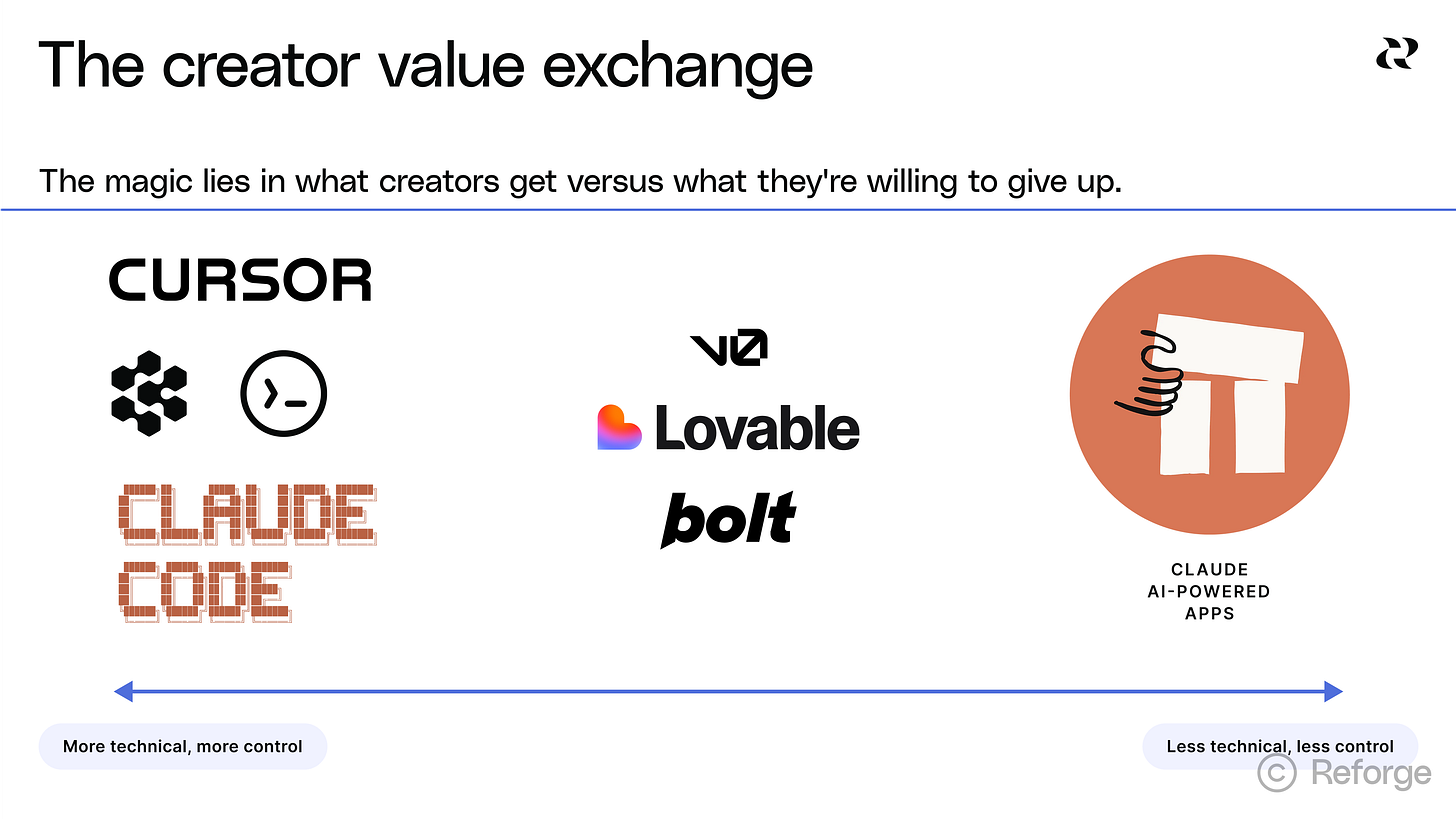How Claude Is Building A Unique Growth Engine Out of User-Created Apps
Anthropic recently launched Claude AI-powered apps. It's unique constraints creates a potentially new powerful growth model. Here is a full breakdown.
One of the things I’ve been watching closely is how AI is creating new types of Growth Loops that we haven’t seen before. Two years ago I wrote about LinkedIn’s AI enhanced content loop that generated 1M uniques per month in record time.
A couple of weeks ago Anthropic launched a new Claude feature called “AI-powered apps.” There are some unique elements to this feature that creates a potentially new powerful growth model. Fareed Mosavat and I broke it down on a recent episode of Unsolicited Feedback.
Listen On: Spotify or Apple Podcasts
What Are Claude AI-Powered Apps?
As Claude describes in the announcement, AI-powered apps in Claude are “the ability to build, host, and share interactive AI-powered apps directly in the Claude app.” It’s basically vibe-coding directly within Claude rather than using a purpose build tool like Cursor, Bolt, Lovable, Replit.
Examples
Here are a few examples:
Educational Tools: A high school teacher created an SAT prep app that generates personalized practice questions based on each student's weak areas. Students log in with their Claude account, and the app adapts its difficulty in real-time.
Business Utilities: A product manager built a requirements analyzer that reads uploaded PRDs and generates test cases, edge scenarios, and potential risks. Teams across her company now use it daily.
Data Analysis: A sales ops team created an app that ingests their CSV exports and lets anyone ask questions in plain English: "Which territories are underperforming this quarter?" or "Show me deal velocity by product line."
Fareed in the Unsolicited Feedback episode highlighted something he built:
"I built an app for one of my kids to do SAT studying. Kind of a pain in the butt in something like Lovable, right? Because I got to get an OpenAI API key... I need to create accounts and all this sort of stuff. I'm not planning on charging for it.”
The platform's versatility and constraints lends itself to diverse range of functional and creative artifacts being shared by the community. What makes these apps special isn't that they were built without traditional coding (you can do that in a ton of places) – it's how they handle the details around authentication and sharing.
The Unique Economics and Constraints
Here's where Claude breaks from other AI app development tools. When someone uses your AI-powered app:
They authenticate with their existing Claude account – No separate login system for you to build or maintain.
Their API usage counts against their subscription, not yours – No worrying about managing model costs. If your app goes viral and gets a million users, you don't get a million-dollar API bill. Each user's prompts count against their own Claude subscription (Free, Pro, or Max). You pay nothing for their usage.
No one needs to manage API keys – Forget about your users needing to enter their API key, usage limits, or security concerns. Claude handles all of that.
As you will see in this post, these constraints create a unique growth model for Anthropic and Claude.
The Core Growth Loop Of AI Powered Apps
Quick Growth Loop Recap
If you've been building products for any length of time, you know that sustainable growth rarely comes from one-off campaigns or viral moments. The products that win create systems that feed themselves – what we coined in 2017 as Reforge Growth Loops.
Think of growth loops as the compound interest of product development. Each cycle through the loop doesn't just add users; it multiplies your growth potential. While traditional funnels have a beginning and end, loops create a continuous cycle where outputs become inputs. You can see a lot of examples and materials here.
Why Growth Loops Matter:
They create predictable, scalable growth without linear increase in costs
They build defensibility through network effects and user-generated content
They align user behavior with business growth naturally
The Three Core Types of Growth Loops
Understanding which type of loop you're building fundamentally changes how you execute:
Viral Loops – Users directly invite other users (think Dropbox's referral program or Zoom meeting invites)
Content Loops – Users create content that attracts new users (Pinterest pins, YouTube videos, Twitter threads)
Paid Loops – Revenue from users funds acquisition of new users through sales loops, paid marketing, and partnerships.
Each type has different constraints, metrics, and optimization strategies. Claude's AI-powered apps create something unique: an ai-powered content loop that creates potentially millions of other mini growth engines.
Claude’s Core Growth Loop For AI-Powered Apps
The core growth loop for Claude’s AI-powered apps looks similar to a User Generated, User Distributed Content Loop used by other companies like Eventbrite - A new user signs up, they create a piece of content, the user distributes that piece of content, which attracts new users.
In the case of Claude it is;
Step One: New Claude user signs up or returns to Claude
A user signs up to Claude or comes back to use Claude.
Step Two: User creates an AI-powered app (no code required)
That same user realizes they can solve a specific problem by building a lightweight application directly within Claude. Maybe it's a custom SAT tutor for their kid, a project tracker for their team, or a specialized calculator for their industry. The key? No technical skills required—just natural language instructions to Claude.
Step Three: Creator shares app with their network
The creator distributes their mini-app to the people who need it. This could be internal sharing within a company, posting in professional communities, or simply sending a link to friends and family. The distribution is organic and targeted—people share solutions with those who have the same problems.
Repeat of Step One: Recipients must authenticate with Claude to use driving new or returning Claude users
This is the crucial mechanism. Anyone who wants to use the shared app must sign up for Claude and authenticate through their system. The app won't work without it.
Repeat of Step Two: Some percentage of new users become creators themselves
Once these new users are in the Claude ecosystem, they discover they can build their own AI powered Apps. The cycle keeps repeating
The incentives and constraints that Claude set up make this loop particularly interesting.
Using Claude Auth - Using Claude authentication both makes it easier for the creator to create an AI powered application, but also drives users back into Claude’s ecosystem.
End User’s Claude Subscription - Since the usage counts against the end user’s subscription w/ Claude, the creator doesn’t have to manage AI costs and complications. More importantly, it drives more use of the subscription probably driving upgrades for Claude.
The Compounding Universe Of Claude Apps
But here is where I think the growth model becomes particularly interesting. Each app built with Claude has it’s own set of growth loops driving users and usage to the application (and therefore Claude).
A project management tool built on Claude might have sharing and collaboration features that drive additional invitations. A specialized calculator might get passed around industry forums. Each app becomes a distribution channel for Claude itself.
This creates what we might call "nested loops"—the core creation-sharing loop at the platform level, plus individual sharing and engagement loops within each created application. The growth compounds not just through individual creators, but through the viral mechanisms built into their individual apps.
The Unique Constraints That Enable This
Creation Constraint
Every growth loop has constraints, bottlenecks that determine whether the system compounds or stalls. Most content loops fail at the creation step - converting enough users to actual creators. Getting users to produce something shareable requires overcoming significant friction: technical barriers, cost concerns, time investment, and unclear value exchange.
In content loops you see two types that work:
Higher % conversion from user → creator with low distribution per piece of content
Lower % conversion from user → creator with high distribution per piece of content
The math has to work between those two numbers in order to get the loop to compound.
Claude has designed some constraints in the system to encourage this creation for different group of the market.
The Creator Value Exchange
The magic lies in what creators get versus what they're willing to give up.
What creators get:
Free hosting and infrastructure: Your app lives on Claude's servers with zero setup. No AWS accounts, no deployment pipelines, no server management. As Fareed Mosavat explains: "I built an app for one of my kids to do SAT studying. Kind of a pain in the butt in something like Lovable, right? Because I got to get an OpenAI API key... I need to create accounts and all this sort of stuff."
No API costs or key management: When someone uses your app, their Claude subscription covers the API costs. You're not monitoring usage limits, managing billing, or worrying about runaway costs if your app goes viral.
Built-in authentication system: User management becomes Claude's problem, not yours. No password reset flows, no security audits, no GDPR compliance headaches. Users authenticate once through Claude, and you're done.
Future distribution potential through gallery: While not the primary value proposition, Claude is signaling a potential future discovery mechanisms through the Artifact gallery.
What creators give up:
User ownership/data: You don't get full control over email lists, usage analytics, or the ability to communicate directly with your users outside of Claude's ecosystem. The relationship belongs to Claude (though they could add things to change this).
Platform independence: Your app is tied to Claude's infrastructure. You can't easily migrate to another platform or offer it as a standalone service.
Monetization options (currently): You still have to code in a way for people to pay/monetize though Claude could launch a payment system in the future. The value exchange is utility, not necessarily business building.
These constraints seem to target a different audience of potential app builders. On one end of the spectrum you have builders that want full control who use things like Cursor, Claude Code, etc. In the middle of the spectrum you have products like Bolt, Lovable, etc for less technical folks that are willing to give up some control. Claude creates even more constraints, enabling an even longer tail of application building for less technical people.
Lessons and Takeaways For Product and Growth Leaders
Let me be clear,I don’t know if this will actually work for a few reasons.
AI app development is crowded with purpose built products for the exact use case.
AI app creation within Claude will need to compete for attention of all the other things someone can do with Claude.
Claude's artifacts approach feels like the opposite end of the strategic spectrum from their other initiatives focusing on hardcore developers and enterprise customers.
But the attempt reveals several insights worth studying, regardless of outcome.
Growth Model Innovation
As Fareed mentions:
“They're basically turning code into content that can be distributed, shared, and drive new users, which I think is unique and new and very cool.”
AI is enabling new variations on growth loops
We're seeing growth mechanics that weren't possible before generative AI. The ability to create functional applications through natural language conversation changes who can be a creator and what creation looks like. Claude isn't the only company experimenting here. New technology capabilities often enable new growth mechanics (and new distribution platforms). When a fundamental capability shifts (like non-technical creation), the growth opportunities shift too.
Sometimes the constraint is the opportunity
Most platforms view constraints as problems to solve. Claude flipped this thinking. Instead of trying to compete with full-featured development platforms, they embraced severe limitations—no persistent storage, no external API calls, no direct monetization and used those constraints to enable a different value exchange.
The key is always how you align incentives across all participants in the loop
Claude's model works (if it works) because every participant gets immediate value:
Creators solve their own problems first
End users get utility without setup friction
Claude captures user growth and engagement
This isn't revolutionary thinking, but it's easy to get wrong. Most platform strategies optimize for one participant at the expense of others.
Start constrained, expand deliberately
Fareed Mosavat makes this point explicitly:
"I like what they've done with making this very, very constrained... I like that it's pretty small and narrow. I like that it really encourages tinkering and ease of use."
The temptation with new growth mechanics is to immediately build for every use case. Claude started with toy-like applications that encourage experimentation rather than business-critical development. This creates room to learn before the stakes get higher.







I’m particularly fascinated by how Claude flips the typical value exchange, but how long before creators start demanding more ownership or monetization options?
Google quietly launched the same feature about a month ago, Gemini powered apps built within Gemini. It's amazing. For some reason it's hidden behind a small button.